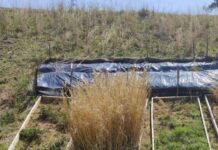
Runoff from urban areas was first recognized as a problem for receiving waters in terms of too much volume in too short of a time period. The solution was to detain the water and release it more slowly. Then it became clear that contaminants in the runoff, including heavy metals and nutrients, were also a problem. One of the solutions was to construct wetlands to both detain the water and treat it by removing some of the contaminants. Two recent studies investigated how well these types of devices perform, with very different conclusions.
Dry detention basins (DB) are constructed to contain stormwater runoff, release it in a controlled manner and drain completely between storm events. The first study evaluated a well-established DB for its ability to retain nitrogen, a common pollutant, over a one-year period.1 The DB drained a 15 ha area of Greenville, NC, USA with a 30% impervious cover. The DB itself was intended to be dry with a grass cover, but over time (10 years), a wet area was formed near the inlet where wetland plants such as Typha spp. (cattails) became established on 40% of the area (Figure 1). Water levels were monitored using stilling wells and loggers, and water quality was monitored at the inlet and outlet during eight storm events. During the warm months, outflow was reduced by 33%, but during the cool season outflow was increased by 18% — likely due to groundwater inputs. Shallow groundwater tables typically are higher in winter in this region. The concentration of total N was reduced in the DB by an average of 21%, although this was highly variable much like the flows. The average total N load was reduced by an average of 52% over the eight storms. The authors suggested that the mix nature of the DB, with some wetland characteristics, may have improved TN reduction from the 10% credit that the state allows for DBs.
While it has been known that constructed wetlands can be a source of greenhouse gases, a recent study suggests that contribution may be much greater than previous studies have indicated.2 The authors sought to quantify the release of three greenhouse gases (CO2, CH4, N2O) from four constructed wetlands in the Melbourne, Australia area. In particular, they wanted to measure releases from both diffusion and ebullition (bubbles), the latter often not being included in many similar studies. Emissions by diffusion were estimated using floating chambers and measuring gas concentrations over 5–10 minutes, while funnels anchored to the bottom were used to collect “bubbles” over the whole week. Measurements were taken both day and night over a four-week period in March. Bottom samples were taken during the first and last week to characterize the microbial communities. Surprisingly, there were no differences in emissions between day and night and little correlation between emissions and water temperature. Higher dissolved oxygen increased CH4 (methane) release while higher turbidity had the opposite effect. Gas bubbles were the dominant source of CH4 but were a minor part of CO2 and N2O releases. There were some relationships between the microbial communities and gas emissions, such as higher abundance of species involved in methane oxidation and lower methane emission. Overall, the inclusion of gas bubbles along with diffusion losses was calculated to increase greenhouse gas emissions from constructed wetlands by threefold compared to other studies.
References
Humphrey, C.P., Jr.; Iverson, G.; Nolan, M. 2022. Nitrogen treatment by a dry detention basin with stormwater wetland characteristics. Hydrology 9, 85. https://doi.org/10.3390/hydrology9050085.
Bonetti, G., S. M. Trevathan-Tackett, N. Hebert, P. E. Carnell, and P. I. Macreadie. 2021. Microbial community dynamics behind major release of methane in constructed wetlands. Applied Soil Ecology 167, 104163. https://doi.org/10.1016/j.apsoil.2021.104163.
About the Expert
Rich McLaughlin, Ph.D., received a B.S. in natural resource management at Virginia Tech and studied soils and soil chemistry at Purdue University for his master’s degree and doctoral degree. He is a professor and extension specialist in the Soil Science Department at North Carolina State University in Raleigh, North Carolina, specializing in erosion, sediment and turbidity control.












